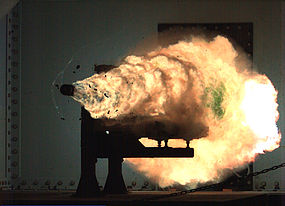Electrothermal-chemical (ETC) technology is an attempt to increase accuracy and muzzle energy of future tank, artillery, and close-in weapon system guns by improving the predictability and rate of expansion of propellants inside the barrel.

A mass driver or electromagnetic catapult is a proposed method of non-rocket spacelaunch which would use a linear motor to accelerate and catapult payloads up to high speeds. Existing and contemplated mass drivers use coils of wire energized by electricity to make electromagnets, though a rotary mass driver has also been proposed. Sequential firing of a row of electromagnets accelerates the payload along a path. After leaving the path, the payload continues to move due to momentum.

A projectile is an object that is propelled by the application of an external force and then moves freely under the influence of gravity and air resistance. Although any objects in motion through space are projectiles, they are commonly found in warfare and sports.
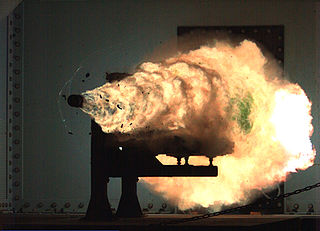
A railgun is a linear motor device, typically designed as a weapon, that uses electromagnetic force to launch high velocity projectiles. The projectile normally does not contain explosives, instead relying on the projectile's high speed, mass, and kinetic energy to inflict damage. The railgun uses a pair of parallel conductors (rails), along which a sliding armature is accelerated by the electromagnetic effects of a current that flows down one rail, into the armature and then back along the other rail. It is based on principles similar to those of the homopolar motor.
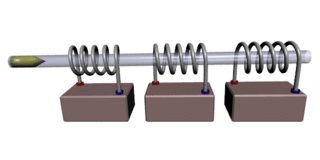
A coilgun, also known as a Gauss rifle, is a type of mass driver consisting of one or more coils used as electromagnets in the configuration of a linear motor that accelerate a ferromagnetic or conducting projectile to high velocity. In almost all coilgun configurations, the coils and the gun barrel are arranged on a common axis. A coilgun is not a rifle as the barrel is smoothbore. The name "Gauss" is in reference to Carl Friedrich Gauss, who formulated mathematical descriptions of the magnetic effect used by magnetic accelerator cannons.
Muzzle velocity is the speed of a projectile with respect to the muzzle at the moment it leaves the end of a gun's barrel. Firearm muzzle velocities range from approximately 120 m/s (390 ft/s) to 370 m/s (1,200 ft/s) in black powder muskets, to more than 1,200 m/s (3,900 ft/s) in modern rifles with high-velocity cartridges such as the .220 Swift and .204 Ruger, all the way to 1,700 m/s (5,600 ft/s) for tank guns firing kinetic energy penetrator ammunition. To simulate orbital debris impacts on spacecraft, NASA launches projectiles through light-gas guns at speeds up to 8,500 m/s (28,000 ft/s).

The formal definition of large-calibre artillery used by the United Nations Register of Conventional Arms (UNROCA) is "guns, howitzers, artillery pieces, combining the characteristics of a gun, howitzer, mortar, or multiple-launch rocket system, capable of engaging surface targets by delivering primarily indirect fire, with a calibre of 75 millimetres and above". This definition, shared by the Arms Trade Treaty and the Treaty on Conventional Armed Forces in Europe, is derived from a definition in United Nations General Assembly Resolution 46/36L, which set a threshold of 100mm. Several grammatical changes were made to that latter in 1992 and the threshold was lowered in 2003 to yield the current definition, as endorsed by UN General Assembly Resolution 58/54.

A ranged weapon is any weapon that can engage targets beyond hand-to-hand distance, i.e. at distances greater than the physical reach of the user holding the weapon itself. The act of using such a weapon is also known as shooting. It is sometimes also called projectile weapon or missile weapon because it typically works by launching solid projectiles ("missiles"), though technically a fluid-projector and a directed-energy weapon are also ranged weapons. In contrast, a weapon intended to be used in hand-to-hand combat is called a melee weapon.
The Naval Ordnance Laboratory (NOL) was a facility in the White Oak area of Montgomery County, Maryland. It is now used as the headquarters of the U.S. Food and Drug Administration.

The Office of Naval Research (ONR) is an organization within the United States Department of the Navy responsible for the science and technology programs of the U.S. Navy and Marine Corps. Established by Congress in 1946, its mission is to plan, foster, and encourage scientific research to maintain future naval power and preserve national security. It carries this out through funding and collaboration with schools, universities, government laboratories, nonprofit organizations, and for-profit organizations, and overseeing the Naval Research Laboratory, the corporate research laboratory for the Navy and Marine Corps. NRL conducts a broad program of scientific research, technology and advanced development.
A magnetic weapon is one that uses magnetic fields to accelerate or stop projectiles, or to focus charged particle beams. There are many hypothesised magnetic weapons, such as the railgun and coilgun which accelerate a magnetic mass to a high velocity, or ion cannons and plasma cannons which focus and direct charged particles using magnetic fields.
MARAUDER was a United States Air Force Research Laboratory project concerning the development of a coaxial plasma railgun. The first computer simulations occurred in 1990, and its first published experiment appeared on August 1, 1993.

The United States Naval Surface Warfare Center Dahlgren Division (NSWCDD), named for Rear Admiral John A. Dahlgren, is located in King George County, Virginia, in close proximity to the largest fleet concentration area in the Navy. NSWCDD is part of the Naval Surface Warfare Centers under the Naval Sea Systems Command (NAVSEA). NSWCDD was initially established 16 October 1918 as a remote extension of Maryland's Indian Head Proving Ground used for testing naval guns. The Dahlgren site was named the Lower Station, Dahlgren Naval Proving Ground when it first opened. The location on the Potomac River was specifically chosen for the development of a long ballistic test range on the Potomac River, required for the testing of modern, high-powered munitions.

The 127 mm (5")/54 caliber lightweight gun is a U.S. naval artillery gun mount consisting of a 127 mm (5 in) L54 Mark 19 gun on the Mark 45 mount. It was designed and built by United Defense, a company later acquired by BAE Systems Land & Armaments, which continued manufacture.
Helical railguns are multi-turn railguns that reduce rail and brush current by a factor equal to the number of turns. Two rails are surrounded by a helical barrel and the projectile or re-usable carrier is cylindrical. The projectile is energized continuously by two brushes sliding along the rails, and two or more additional brushes on the projectile serve to energize and commute several windings of the helical barrel direction in front of and/or behind the projectile. The helical railgun is a cross between a railgun and a coilgun. They do not currently exist in a practical, usable form.

Naval Support Activity Panama City, is a military shore installation of the United States Navy located in Bay County, just outside Panama City, Florida. Among its various tenant commands, it houses the Naval Surface Warfare Center Panama City Division, the Center for Explosive Ordnance Disposal & Diving (CENEODDIVE), the Navy Experimental Diving Unit (NEDU), and Coast Guard Station Panama City.

The United States battleship retirement debate was a debate among the United States Navy, Marine Corps, Congress, and independent groups over the effectiveness of naval gunfire support (NGFS) provided by Iowa-class battleships, and whether or not an alternative should be implemented. The debate centered on the best way to provide fire support for amphibious assault and other troops near a shoreline.
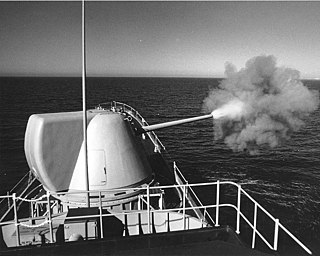
The U.S. Navy's Major Caliber Lightweight Gun (MCLWG) program was the 8"/55 caliber Mark 71 major caliber lightweight, single-barrel naval gun prototype that was mounted aboard the USS Hull (DD-945) in 1975 to test the capability of destroyer-sized ships to replace decommissioned cruisers for long-range shore bombardment. United States naval gun terminology indicates the gun fired a projectile 8 inches (203 mm) in diameter, and the barrel was 55 calibers long
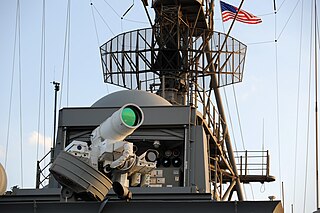
The AN/SEQ-3 Laser Weapon System or XN-1 LaWS is a laser weapon developed by the United States Navy. The weapon was installed on USS Ponce for field testing in 2014. In December 2014, the United States Navy reported that the LaWS system worked perfectly against low-end asymmetric threats, and that the commander of Ponce was authorized to use the system as a defensive weapon.
The Cannon-Caliber Electromagnetic Gun (CCEMG) launcher was a rapid-fire railgun launcher developed by the U.S. military in the early 1990s to study and test the viability of electromagnetic weapons.
